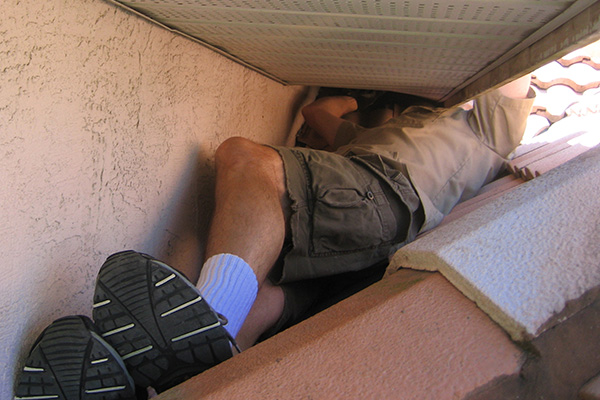- info@animalatticpest.com
- Call - we service 300 locations

Inspection - How to Find the Animal Entry Holes Into Your House
The home inspection is the most critical step in the wildlife removal process. The animals in your attic are getting in somehow - but where? It's not always so simple to find. If you don't find 100% of the entry holes, you will never permanently
solve the problem with the animals in your attic. You won't even be able to remove certain animals at all, unless you can find the entry/exit holes. It's important to note that animals need to drink and eat, and thus they repeatedly leave your attic
and come back. The entry holes aren't always easy to find, but animals leave many clues behind.
House Exterior: First of all, you have to be comfortable using a ladder and crawling on the roof. You have to be aware of all safety precautions. If you are not, then don't do it yourself! Hire a professional! Use the ladder to inspect all parts of the house:
Look for poorly screened roof vents, or places where the soffit meets the roof, or eave vents, or wooden fascia boards that they can chew through. Look for chewing damage, brown fur grease, and animal tracks. Look for chewed out ridge cap vents, open
plumbing stacks, or a hole in the roof itself. Your home might have several entry areas. And don't forget the chimney. That can lead into the attic sometimes, or you may end up with critters living in there. Read All About Animals In The Chimney.
A knowledge of both building architecture and wildlife behavior helps a great deal here. An experienced wildlife professional knows which areas to inspect, and how animals use certain vulnerabilities.
Inside the Attic: Next, climb in the attic. You'll want to wear a headlamp to see, and a HEPA filter mask so that you don't breathe in fiberglass insulation or animal feces. Be very careful to only walk on the wooden beams or trusses! If you
step on the drywall ceiling, you might fall through! Check every part of the attic, and look at all the wires and ducts, to
check for damage. Look for the animal feces and the tracks and tunnels in the insulation. In addition, with certain species such as raccoons and squirrels, you must find the nest of baby animals.
Inspection - How to Find the Animal Entry Holes Into Your House
Use a Ladder
Inspect the exterior of the home, including the roof and all vents, to find out how the animals are getting in. Most animals in the attic enter at roof level.
Inspect Inside the Attic
This is very important. It will help you identify the animal species (look for droppings and tracks), and you will find out the extent of the animal damage.
Find the Entry Holes
You have to find out how they are getting in. Not all entry holes will be this obvious. Many will be behind vents, or small gaps where the eave meets the roof, things like that.
Information About Inspection - How to Find the Animal Entry Holes Into Your House
Inspection Tools: First and foremost is a good ladder which allows you access to the roof and all the eaves and other high areas animals use to enter the house. The size of ladder you need will depend on the
height of your house. A 24-foot ladder works in most 2-story situations, or a 12-foot ladder for a single-story home, but I break out my 32-foot and even my 40-foot ladder regularly for larger buildings. You may also need a
stepladder to get into the attic. Next, you'll want a headlamp when you inspect inside the attic. Add other attic safety equipment such as a filter mask, preferably a HEPA rated one, which filters out airborne animal
waste and insulation fibers. I also like to wear a disposable Tyvek suit, as well as a good pair of gloves.
Repairs: For some types of animals like rats or mice, you'll want to immediately seal all the entry holes you find. For others, you'll want to leave the primary hole open, but seal shut all the secondary holes. Read
about entry hole repairs to learn more about how to properly fix the holes.
The Bottom Line
The home inspection is the most important step in solving a problem with animals in your attic. They are getting in somehow, and you have to find out where in order to solve the problem. You also have to inspect inside the attic to find the species and extent of damage and any nest of babies. You can't just set some traps without doing the job correctly, with a full inspection!




